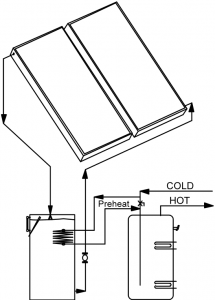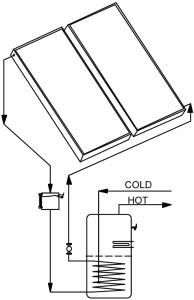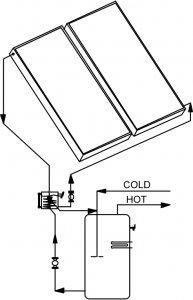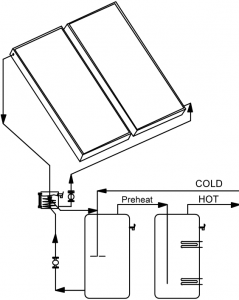Different Kinds of Drainback Solar Water Heating Systems
Most people don’t know that there are different kinds of drainback solar water heating systems. Some look very much like glycol systems with the important difference that they contain no glycol, expansion tanks, check valves, or any other components required for dealing with pressurization. The water drains out of the collectors when the pump stops.
The design we recommend is called the Type 1 drainback system, shown in Figure 1 (click for larger image). The drainback tank is a full size unpressurized solar storage tank. There is no heat exchanger between the collectors and the tank for the highest solar collection efficiency. The heat exchanger is on the load side.
This is called a two tank system since the solar storage is completely separate from the conventional water heater. Type 1 drainback systems are scalable from very small to very large. As the system size get larger, the benefits of non-pressurized drainback become even greater over a pressurized glycol system.
Type 2 and Type 3 drainback systems are single tank systems developed mainly for small residential systems to get away from the problems associated with pressurized glycol. Figures 2 and 3 show these two types, which differ in where the heat exchanger is placed. Type 2 and 3 drainback systems have LOW pressure collector loops (not NO pressure) with a heat exchanger between the collectors and the tank.
Low pressure means they are not pressurized up to the line pressure of potable water. The collector water drains back into a reservoir tank, which is too small to be considered as the solar storage volume. It is better to think of the drainback reservoir as a “module”, or component in the system.
Type 2 uses a special solar water heater with a heat exchanger built in. Only one pump is needed to run the collector loop. This is a single tank configuration with the solar storage volume and the regular water heater volume in the same tank, typically divided about 50:50. Single tank systems all have the same problems. The solar storage volume is less than it should be, lowering the collector efficiency, and there is always energy mixing where the electric element adds some energy to the solar storage, lowering the solar efficiency. For example, an 80 gallon single tank system will have about 40 gallons of “solar” storage, limiting the collector area to about 60ft2, and 40 gallons of conventional electric heat storage. A two tank system, by contrast, can have a full 80 gallons of solar storage, with a 40-80 gallon conventional water heater.
Also, single tank solar systems don’t work with gas water heaters, because the flame is at the bottom of the tank where the solar storage is supposed to be. The special water heaters used in Type 2 drainback are much more expensive than regular water heaters but don’t last any longer, typically 7-10 years. When one wears out and starts to leak, the replacement can be expensive.
Type 3 drainback systems get around the need for a special water heater by putting the heat exchanger inside the small reservoir tank. The water heater can now be any conventional (energy efficient) electric model. However, Type 3 drainback systems require a second pump to circulate the water to the water heater, and the solar equipment cost goes up slightly. Since the heat exchanger is in a small reservoir, its size is smaller than the Type 2 exchanger, so limitations occur in system size. The cold water dip tube is usually cut off at half height to prevent the solar heated water from going right into the supply line at the bottom of the tank.
Either Type 2 or Type 3 drainback systems can also be used in two tank systems as shown in Figure 4. In this case, the first tank is a full size solar storage tank which supplies preheated water to a conventional water heater.
Although technically feasible, there is no reason to choose a Type 4 over a Type 1, since they have more components and are less efficient.
To summarize, two tank systems have several advantages over single tank systems. They can be used effectively with any type gas, electric, and instantaneous water heaters. They have separate full solar storage and water heater volumes.
Note that some instantaneous water heaters don’t have controls sophisticated enough to take preheated water and boost it to the final temperature. Be sure to check when choosing an instantaneous water heater.
Dr. Ben
PS – Don’t forget to leave your thoughts and/or questions in the comment section below.
6 Responses to “Different Kinds of Drainback Solar Water Heating Systems”
Comments
Read below or add a comment...





Dr. Ben,
Thanks for a good summary of the most popular systems.
You said, “single tank solar systems don’t work with gas water heaters, because the flame is at the bottom of the tank where the solar storage is supposed to be.”
Bradford White would probably disagree, because they now offer a single tank solar storage/heater fired by natural gas.
For information on how it works, go to http://greenbuildingindenver.blogspot.com/2011/08/important-new-solar-tank-from-bradford.html
The jury is out as to whether it REALLY works.
Thank You very much for the basic designs! It confirms some of my thoughts for a two tank system to preheat my domestic water. I would also like to add some radiant baseboard heaters to heat the lower walkout level of my house so the main level will require less forced air heating.
Maybe I could add a heat pump later on for cooling during the Summer!?
Can you recommend any books for a begginer who has a good grasp of most of the hardware in a drainback syatem? Since I am a top level water & wastewater treatment operator who has also worked a number of years for Graingers, most everything is familliar, but there are still a lot of questions! I would rather not reinvent the wheel and avoid all mistakes.
Thank You for your work!!!
Wallace Canterbury
Dear Dr.Ben,
Usually I design Type 2 system without heat exchanger inside the reservoir tank. I think that if we use a “solar” storage as a preheater (without another heat source), it is a good scheme. The exit of the solar storage can go inside the storage of the boiler. So the solar efficency in not influenced by the boiler.
Furthermore, the design with an external reservoir tank is a more flexible scheme. It’s possible to change the height of the reservoir tank to limit the static head that the pump have to overcome during the start-up of the system.
Do you agree?
Best regards.
Marcello,
First, type 2 and 3 drainback systems are by definition single tank systems, which are not as efficient as two tank solar systems. There are times when two tanks are too big for the space in an apartment, but there are ways to mount a 40gal conventional water heater over an 80 gallon drainback tank. I understand European water heaters are smaller than US ones.
If one of these system is going to be used anyway, then installing the drainback reservoir tank high to lower the pump head is a good idea. However, there are specific limitations to both type 2 and type 3 systems that must be considered.
A type 2 drainback system (exchanger in/on the tank) requires a specially made water heater with the exchanger built in. They usually have the same lifetime as a regular water heater (about 7 years), but cost a lot more. Some argue for externally wrapped exchangers around the outside of the tank, and some favor internal exchangers inside the tank. Either can work well if designed right.
In a type 3 drainback system (exchanger in the reservoir), there is limited space for the exchanger, so it may not be as big as it should be. Also, if the volume in the collectors and piping is large, the water drop in the reservoir may uncover part of the exchanger. This means you should be careful that all the numbers add up. The exchanger must be the right size and it should not be uncovered as the collectors fill. Type 3 drainback system require two pumps – collector and exchanger.
In all cases, a drainback system is more efficient than a glycol system and has a longer lifetime.
Hi Dr. Ben,
am a fan of your site from Germany and find this excellent as they explain everything.
Here in Europe, only a few people are intelligent to understand the drain-back system.
We now have a facility is built as a drain back to a storage of 130,000 liters of polypropylene and 200 vacuum tube collectors.
Video on my site: http://www.agritec-solar.eu
best regards
Günter
Thank you to explain briefly the most popular water heating system.This system is very useful with the help of this water heating system we save too much energy.For more information visit
http://www.rousehillirrigation.com.au/